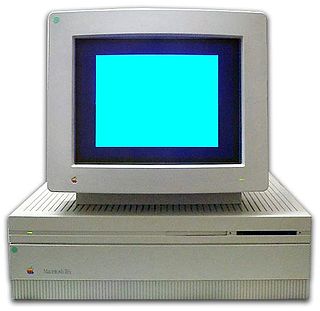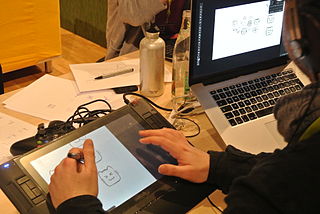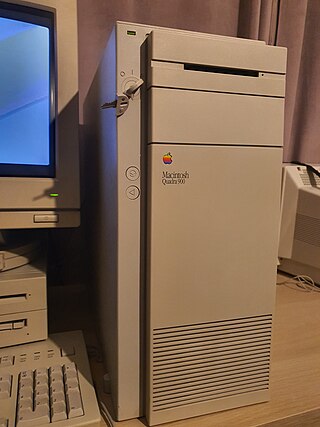Related Research Articles

Exile is a series of role-playing video games created by Jeff Vogel of Spiderweb Software. They were released as shareware titles for Macintosh and Windows systems. Exile III was also ported to Linux by a third party. There were four games released in the series. All of the games were later revived in the Avernum series. Common to all games in the Exile series are 2D graphics and basic sound. The graphics in the first versions of Exile I and II had simple textures, colours and outlines, which were then replaced in later versions with Exile III's graphics. The games are designed to be non-linear and long in gameplay length.
In computing, WYSIWYG, an acronym for What You See Is What You Get, refers to software which allows content to be edited in a form that resembles its appearance when printed or displayed as a finished product, such as a printed document, web page, or slide presentation. WYSIWYG implies a user interface that allows the user to view something very similar to the result while the document is being created. In general, WYSIWYG implies the ability to directly manipulate the layout of a document without having to type or remember names of layout commands.

The Macintosh Classic is a personal computer designed, manufactured and sold by Apple Computer from October 1990 to September 1992. It was the first Macintosh to sell for less than US$1,000.

MacPaint is a raster graphics editor developed by Apple Computer and released with the original Macintosh personal computer on January 24, 1984. It was sold separately for US$195 with its word processing counterpart, MacWrite. MacPaint was notable because it could generate graphics that could be used by other applications. It taught consumers what a graphics-based system could do by using the mouse, the clipboard, and QuickDraw picture language. Pictures could be cut from MacPaint and pasted into MacWrite documents.

The Macintosh II is a personal computer designed, manufactured, and sold by Apple Computer from March 1987 to January 1990. Based on the Motorola 68020 32-bit CPU, it is the first Macintosh supporting color graphics. When introduced, a basic system with monitor and 20 MB hard drive cost US$5,498. With a 13-inch color monitor and 8-bit display card the price was about US$7,145. This placed it in competition with workstations from Silicon Graphics, Sun Microsystems, and Hewlett-Packard.

The Macintosh IIfx is a personal computer designed, manufactured and sold by Apple Computer from March 1990 to April 1992. At introduction it cost from US$9,000 to US$12,000, depending on configuration, and it was the fastest Macintosh available at the time.

The Macintosh IIci is a personal computer designed, manufactured, and sold by Apple Computer, Inc. from September 1989 to February 1993. It is a more powerful version of the Macintosh IIcx, released earlier that year, and shares the same compact case design. With three NuBus expansion slots and a Processor Direct Slot, the IIci also improved upon the IIcx's 16 MHz Motorola 68030 CPU and 68882 FPU, replacing them with 25 MHz versions of these chips.
MacDraw is a discontinued vector graphics drawing application released along with the first Apple Macintosh systems in 1984. MacDraw was one of the first WYSIWYG drawing programs that could be used in collaboration with MacWrite. It was eventually adapted by Claris and, in the early 1990s, MacDraw Pro was released with color support. MacDraw was the vector-based cousin of MacPaint.
GraphicConverter is computer software that displays and edits raster graphics files. It also converts files between different formats. For example, one can convert a GIF file to a JPEG file.

Digital painting is the creation of imagery on a computer, using pixels which are assigned a color. The process uses raster graphics rather than vector graphics, and can render gradiated or blended colors in imagery which mimics traditional drawing and painting media.
The Print Shop is a desktop publishing software package originally published in 1984 by Broderbund. It was unique in that it provided libraries of clip art and templates through a simple interface to build signs, posters and banners with household dot-matrix printers. Over the years, the software has been updated to accommodate changing file formats and printer technologies.

The Macintosh Quadra 950 is a personal computer designed, manufactured and sold by Apple Computer from March 1992 to October 1995. It replaced the Quadra 900 that was introduced several months earlier, increasing the CPU clock rate of its 68040 CPU from 25 MHz to 33 MHz, and improving the graphics support. The two computers were otherwise identical, including the price. With a Macintosh Processor Upgrade Card installed, this computer is known as the Power Macintosh 950.
Raster graphics editors can be compared by many variables, including availability.

Epic Pinball is a 1993 pinball video game developed by James Schmalz and published by Epic MegaGames. The initial release pre-dated Schmalz' Digital Extremes name. The game is played seen from a 2D top-down view within a scrollable window with plain raster graphics in 320x240. It was noted for being programmed entirely in x86 assembly language for MS-DOS systems.
Red Ryder is a communications and terminal emulation software program released for the Apple Macintosh in 1984. Initially distributed as a shareware, the application offered rich features and configuration settings. Red Ryder was discontinued in 1989 and replaced by White Knight.

The Macintosh Quadra 900 is a personal computer designed, manufactured, and sold by Apple Computer from October 1991 to May 1992. It was introduced alongside the Quadra 700 as the first computers in the Quadra family of Macintosh computers using the Motorola 68040 processor. It is also the first computer from Apple to be housed in an 18.6 inch tall mid-tower form factor, which by 1991 had gained momentum with PC manufacturers as a suitable design for departmental servers.

SuperPaint is a graphics program capable of both bitmap painting and vector drawing. SuperPaint was one of the first programs of its kind, combining the features of MacPaint and MacDraw while adding many new features of its own.
PC Paintbrush was a graphics editing software created by the ZSoft Corporation in 1984 for computers running the MS-DOS operating system.

The Macintosh Quadra 660AV, originally sold as the Macintosh Centris 660AV, is a personal computer designed, manufactured and sold by Apple Computer from July 1993 to September 1994. It was introduced alongside the Quadra 840AV; the "AV" after both model numbers signifies video input and output capabilities and enhanced audio.
References
- ↑ Bilbo, Mark; Maki, Ken (1992). "Chapter Twenty-Five: Using LightningPaint". Big Mac Secrets. Carmel, IN: Que Corporation. pp. 1019–1080. ISBN 0-88022-992-6.
- ↑ Prevost, Ruffin; Terrell, Rob (1994). "Chapter 9: Graphics & Clip Art". The Mac Shareware 500: The Last Word on the Best Virus-Free Mac Shareware, Second Edition. Ventana Press. pp. 229–230. ISBN 1-56604-076-0.